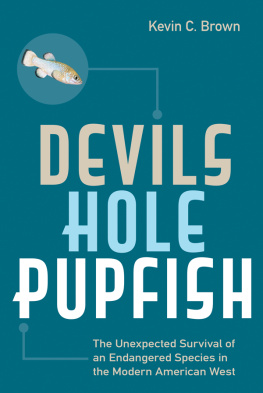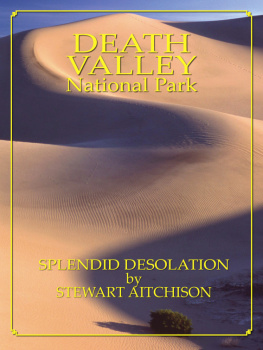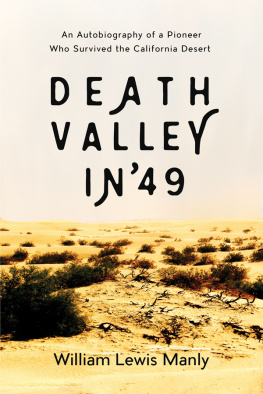AMERICAS NATIONAL PARKS SERIES
Series Editor, Michael Welsh, University of Northern Colorado
Americas National Parks promotes the close investigation of the complex and often contentious history of the nations many national parks, sites, and monuments. Their creation and management raises a number of critical questions from such fields as archaeology, geology and history, biology, political science, and sociology, as well as geography, literature, and aesthetics. Books in this series aim to spark public conversation about these landscapes enduring value by probing such diverse topics as ecological restoration, environmental justice, tourism and recreation, tribal relations, the production and consumption of nature, and the implications of wildland fire and wilderness protection. Even as these engaging texts cross inter-disciplinary boundaries, they will also dig deeply into the local meanings embedded in individual parks, monuments, or landmarks and locate these special places within the larger context of American environmental culture.
Death Valley National Park: A History
by Hal K. Rothman and Char Miller
Grand Canyon: A History of a Natural Wonder and National Park
by Don Lago
Lake Mead National Recreation Area: A History of Americas First National Playground
by Jonathan Foster
Coronado National Memorial: A History of Montezuma Canyon and the Southern Huachucas
by Joseph P. Sanchez
Glacier National Park: A Culmination of Giants
by George Bristol
Big Bend National Park: Mexico, the United States, and a Borderland Ecosystem
by Michael Welsh
Devils Hole Pupfish: The Unexpected Survival of an Endangered Species in the Modern American West
by Kevin C. Brown
University of Nevada Press | Reno, Nevada 89557 USA
www.unpress.nevada.edu
Copyright 2021 by University of Nevada Press
All rights reserved
Cover illustration Joseph Tomelleri
Cover design by Iris Saltus
All photos, images, and illustrations by author unless otherwise noted.
LIBRARY OF CONGRESS CATALOGING-IN-PUBLICATION DATA
Names: Brown, Kevin C. (Kevin Conor), 1984 author.
Title: Devils Hole pupfish : the unexpected survival of an endangered species in the modern American West / Kevin C. Brown.
Description: Reno ; Las Vegas : University of Nevada Press, [2021] | Includes bibliographical references. | Summary: The Devils Hole pupfish is one of the rarest vertebrate animals on the planet; its only natural habitat is a ten-by-sixty-foot pool near Death Valley, on the Nevada-California border. Isolation in Devils Hole made the fish different from its close genetic relatives, but as the book explores, what has made the species a survivor is its many surprising connections to the people who have studied, ignored, protested, or protected it Provided by publisher.
Identifiers: LCCN 2021010749 | ISBN 9781647790103 (paperback) | ISBN 9781647790110 (ebook)
Subjects: LCSH: Devils Hole pupfishConservationHistory. | Rare fishesConservationNevadaDevils Hole. | Devils Hole (Nev.)
Classification: LCC QL638.C96 B76 2021 | DDC 597.16809793/34dc23
LC record available at https://lccn.loc.gov/2021010749
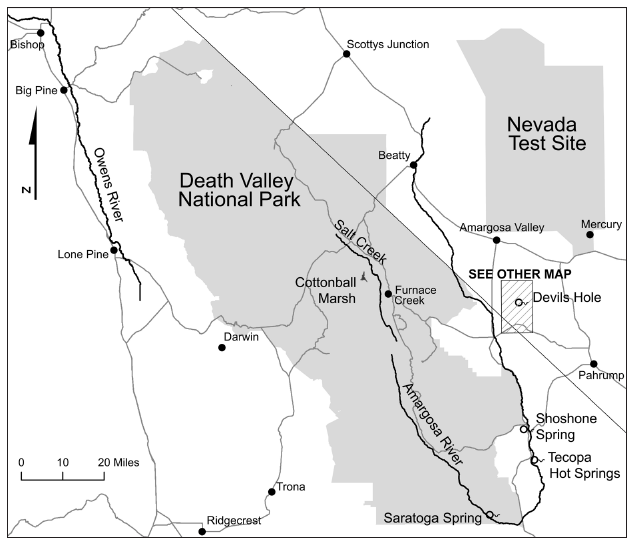
FIGURE 0.1. Death Valley National Park and environs, showing principal roads and towns. Rivers and springs that once contained or still contain pupfish are also shown. Map by author with public-domain data.
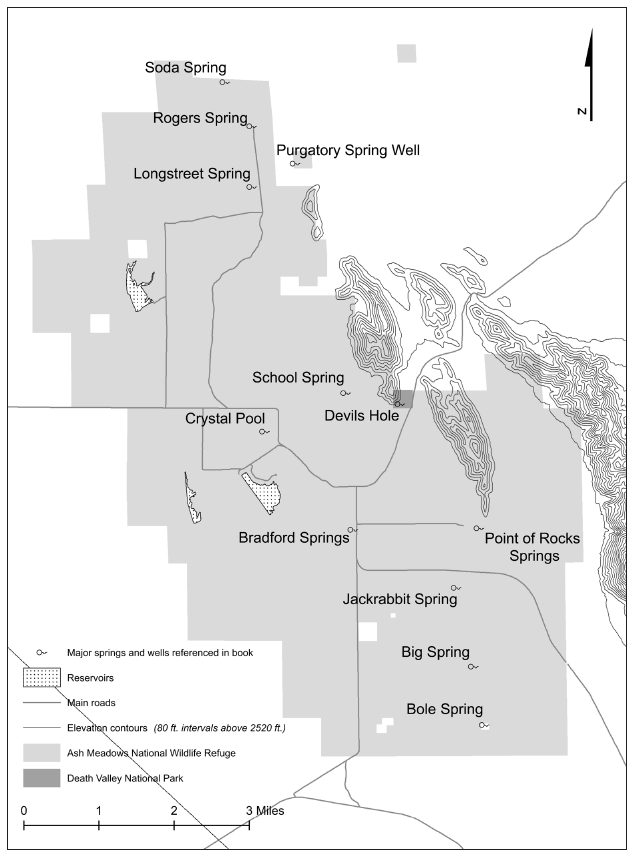
FIGURE 0.2. Devils Hole and Ash Meadows area. Map by author with public-domain data.
Introduction
Surviving the Meteor
Sixty thousand years ago, the roof of a water-filled cavern collapsed just east of Death Valley in what is now southern Nye County, Nevada. Nineteenth-century Anglo American visitors, channeling a cosmology that saw dark forces in both geological oddities and the wilderness, named the place Devils Hole.
This roughly funnel-shaped feature is, improbably, a window into a vast subterranean lake.).
Deserts are defined by their aridity. But Devils Hole is on the eastern edge of a relatively lush patch of the Amargosa Desert called Ash Meadows. Along a series of faults that run on a northwestsoutheast line near Devils Hole, a network of more than a dozen large springs and numerous seeps discharges some 10,000 gallons of water every minute, producing oases in the desert that stretch across some 50,000 acres.
This book is about one of these species, an inhabitant of the strange pool on the edge of the Ash Meadows oasis, a one-inch-long, twitchy blue fish: Cyprinodon diabolis, the Devils Hole pupfish (depth of Devils Hole, the pool is just 10 feet wide by 60 feet long at its surface. The pupfish live only in a small zone near the top of the water column, where invertebrates and algae (i.e., pupfish food) are found. They spawn exclusively in an even more restricted area: a chunk of rock that scientists call the shallow shelf, wedged into the southern third of the pool and barely below the waterline. The entire species, which at times has had a population of fewer than 40 observed fish, could barely stock a suburban dental office aquarium. The pupfishs only natural home is Devils Hole, and biologists consider the fish to have the smallest habitat for a vertebrate species in the entire world. Even within the species-rich island of Ash Meadows, the Devils Hole pupfish is rare and unique, a fact that helped make it a founding member of the U.S. endangered species list when it was created in 1967.
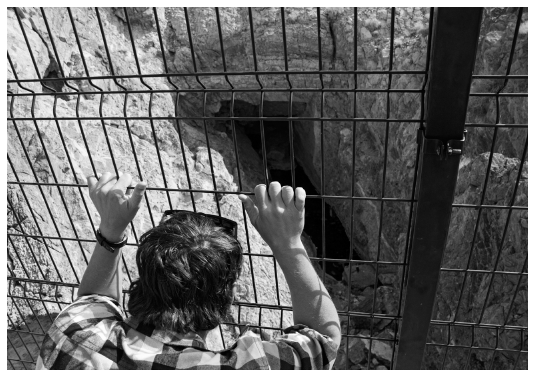
FIGURE 0.3. Devils Hole, as it can be seen today from Death Valley National Parks wire-encased viewing platform.
Arriving sometime after Devils Hole became open to air and light though exactly when is subject to lively debatethe Devils Hole pupfish was shaped by its isolation in an extreme environment. The water in Devils Hole, in addition to its high temperature, has very little dissolved oxygen. Direct sunlight does not even reach the pool in winter. As a result, more than half of the total annual energy available in Devils Hole comes from plants,
Yet the Devils Hole pupfish is a tenacious survivor, enduring not just a harsh physical environment, but also recent American history. Nineteenth-century Anglo-Americans often regarded deserts as places to avoid or navigate quickly, an attitude in sharp contrast to the Newe (Western Shoshone) and Nuwuvi (Southern Paiute) peoples that have made the land around Ash Meadows a homeland. The group that gave Death Valley its dour namea party of easterners seeking their fortunes in the California gold fieldseven passed by Devils Hole on December 23, 1849, and at least two members enjoyed a swim in the pool.
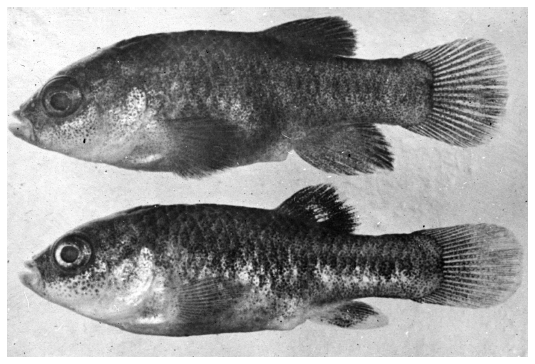
FIGURE 0.4. Preserved specimens of Devils Hole pupfish (Cyprinodon diabolis) in the collection of researcher Carl Hubbs. Photograph courtesy of Carl Leavitt Hubbs papers, Special Collections and Archives, University of California, San Diego.
The twentieth century brought new uses to the desert around Devils Hole. The U.S. military reserved vast swaths of Nevada and California for airfields, bombing ranges, and a destructive new test site far from the prying eyes of citizens and spies, while the National Park Service (NPS) promoted tourism and expanded its holdings at its desert parks, including Death Valley National Monument in 1933. (The monument was expanded and redesignated as Death Valley National Park in 1994.) These two very different categories of federal lands sometimes intersected at Devils Hole. In 1951, just a year before President Truman added Devils Hole to the Death Valley monument, the government began testing nuclear weapons north of Devils Hole at the Nevada Test Site. Some blasts caused water in Devils Hole to slosh back and forth. Ultimately, more than 1,000 nuclear weapons were detonated.

